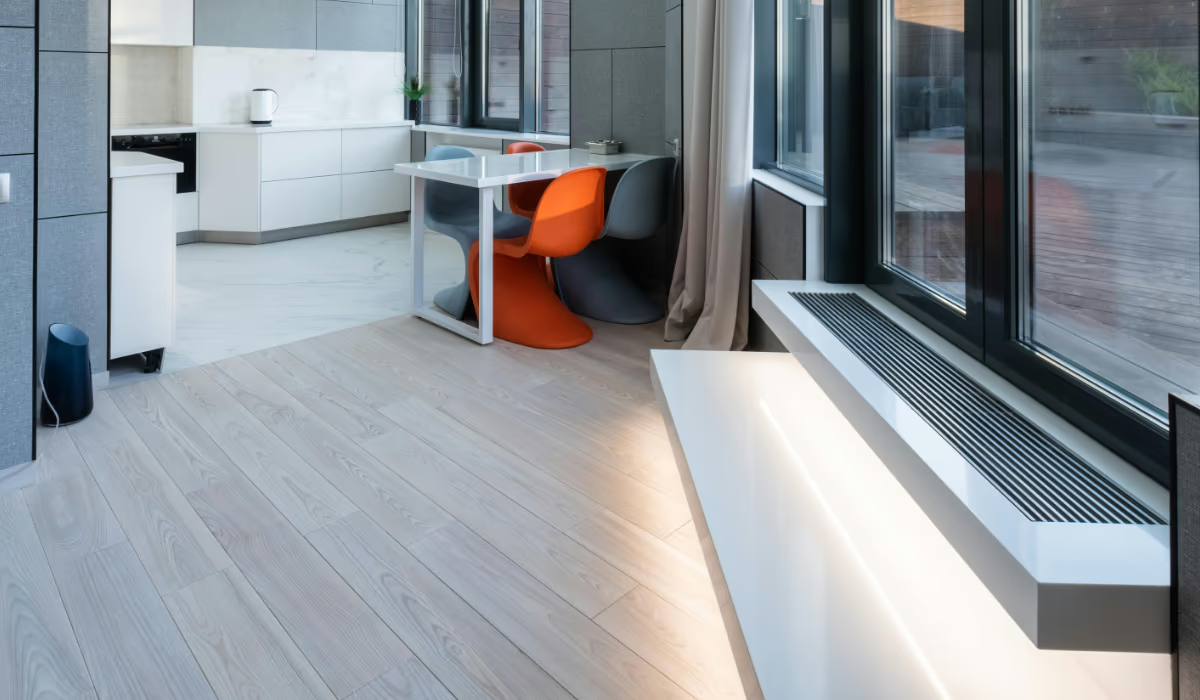Flooring is a long-term investment. What looks trendy today may feel stale or forced later. Because you don’t usually change floors often, a design misstep is more noticeable and costly to reverse. Designers in 2025 are calling out certain flooring choices whose appeal is fading or whose practical downsides are too strong. Knowing what to avoid helps you pick floors that last in style and use.
Gray-Toned Wood
Gray wood flooring has ruled interiors in recent years, offering a neutral, modern backdrop. But designers now argue it feels cold, flat, and uninspiring. In many spaces, gray tones lack the warmth and emotional pull that natural wood finishes bring. Homes look more inviting when warmer, natural wood tones replace the starkness of grays.
Tiny Hexagon Mosaic Tiles
Small hexagon mosaic tiles were once beloved for bathrooms and decorative floors. Their charm, however, comes with many grout lines—hard to keep clean—and a look that’s becoming too distinctive and dated. Designers suggest that in 2025, floors should be more seamless, with larger formats or simpler shapes that reduce visual clutter and maintenance burden.
Faux Barnwood & Overly Distressed Textures
The imitation “barnwood” or heavily distressed wood look is losing favor. While reclaimed real wood retains its authenticity, manufactured versions often feel contrived. Overdone distressing or fake wear patterns tend to read as pastiche rather than character. Designers now favor a subtle texture that feels natural—hand-scraped, lightly wire-brushed—rather than dramatic, forced aging.
High-Gloss Finishes
High-gloss flooring (in hardwood, tiles, or laminate) was once prized for its shine and elegance. But that shine is also a drawback: it exposes every dust speck, scratch, scuff, and imperfection. Over time, maintenance becomes a chore. 2025 leans toward matte or satin finishes that mask wear better, feel more subtle, and age gracefully.
Skinny, Narrow Planks & Overly Patterned Floors
Thin, narrow wood planks, once used to elongate rooms or suit traditional styles, are being phased out for feeling busy and fragmented. Wider planks that show more continuous grain provide a cleaner, more modern flow. Likewise, overly bold or repeat patterned floors—especially ones trying too hard to “make a statement”—are considered overwhelming and risk becoming dated quickly.
Conclusion
As interior design evolves, several flooring trends once embraced are now on the decline: gray-toned woods, tiny mosaics, faux barnwood, glossy surfaces, narrow planks, and heavy patterning. The shift is toward authenticity, warmth, understated finishes, and materials that age well. Choosing floors with natural texture, soft sheen, wide planks, and timeless tones helps your space endure style cycles without feeling stuck in the past.
FAQs
Are all gray floors “outdated”?
Not necessarily. Muted, warm grays with undertones and paired with warm accents can still work. It’s the cold, flat grays dominating entire floors that are losing favor.
What finish is best to hide wear and tear?
Matte or satin finishes do a much better job of concealing minor scratches, dust, or imperfections compared to glossy finishes.
Can I keep a pattern but make it modern?
Yes—use larger patterns, subtle textures, or partial runs instead of full, bold repeats. Patterns work best as accents or in smaller zones.
Do narrower planks ever make sense?
They still have their place in small rooms or historic homes, but for open or modern layouts, wider planks usually feel more cohesive and contemporary.
Is it risky to follow current trends for something like flooring?
Always some risk exists. That’s why many designers recommend neutral base floors with personality added via rugs, furniture, or accents. Floors that are too “on trend” may date faster than the rest of your design.







